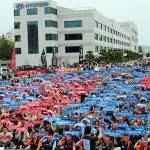South Koreas Samsung Group, through its affiliates, clinched a deal Friday to buy German lighting specialist Novaled AG for 260 million euros ($347 million), in a move highlighting the electronic giants ambition to expand in next-generation technologies.
Samsung has been very active towards acquiring small companies with technologies used in consumer electronics. The latest deal will help the group secure a better foothold in the market for next-generation displays employing organic light-emitting diodes. OLED displays are now used widely in smartphones but are also increasingly being adopted in televisions for their energy efficiency and ability to reproduce vivid colors. Revenue in the OLED display market is pointed to grow to $20 billion by 2017 from just $8 billion in 2012, according to market research firm DisplaySearch.
Samsung will buy Novaled through its affiliate Cheil Industries Inc., which makes electronic materials for OLED displays, and its electronics arm, Samsung Electronics Co.
“Through the acquisition of Novaled, Cheil Industries strengthens its leading position in the field of electronic materials, and we are able to achieve significant synergies in research and development of OLED material of the next generation,” said for the Wall Street Journal Jong-Woo Park, chief executive of Cheil Industries. Cheil will acquire 50% in Novaled, while Samsung will buy 40%. Samsungs venture capital arm already holds the other 10% in the Dresden-based company.
Novaled is especially positioned to profit from the market for next-generation OLED TVs, according to analysts. While mobile phones are the largest application for OLEDs, accounting for 71% of the total market in 2012, analysts expect TVs to surpass them by 2015.
Samsung Electronics in late July said its panel-making unit Samsung Display Co. has conceived a total of 6.5 trillion won ($5.8 billion) in capital expenditure this year, most of which will go to expanding OLED manufacturing facilities.
Technical difficulties had stopped the company from manufacturing budget priced models TVs. Despite the problems which Samsung should overcome, company has been heavily investing in the technology. It aims to develop expertise in the area to get an edge against rivals elsewhere in Asia, who wont catch up on the technology as fast as they did with liquid-crystal displays.
“Were continuously widening the technological gap between (Samsung) and rivaling companies,” Robert Yi, head of investor relations at Samsung Electronics said in July. He said the company aims for another technology “leap” with diversified OLED applications, including flexible displays.





